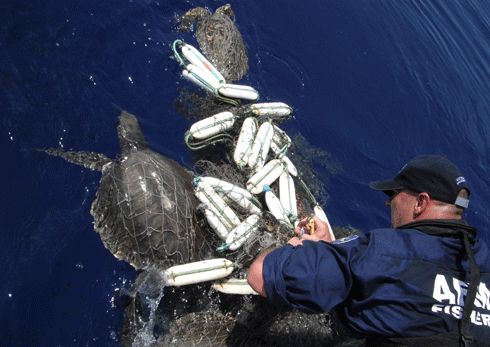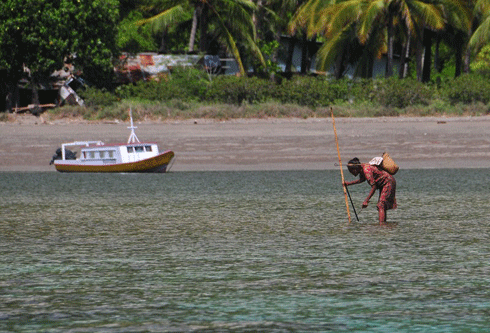
|
Published: 11 February 2013
Sea turtles caught up in ghostnets’ random harvest
Each year around 640,000 tonnes of fishing gear is lost or thrown overboard by the fisheries around the world. These ‘ghostnets’ drift through the oceans and can continue fishing for many years. They kill huge numbers of marine mammals, sea turtles and sea birds, and cause significant loss of biodiversity.

|
|
Entangled sea turtles being freed from dangerous ghost nets by an Australian Fisheries Management Authority officer.
Credit:
AFMA
|
One study showed fur seal populations declined around 5 per cent each year. Ghostfishing of commercially valuable fish species also reduces food resources.
Ghostnets are a global problem: they’re found even on remote atolls thousands of kilometres from commercial ports. But they are a particular problem in Australia’s Gulf of Carpentaria. Here, ghostnets wash ashore at densities reaching up to three tonnes/km, among the highest in the world.
We don’t know where more than half the nets come from, but of the nets we can identify, most come from fisheries in neighbouring Asian countries. About 4 per cent come from Australia. Because of the large amount of illegal fishing that has occurred in the region, it’s not clear whether they were lost or left behind intentionally.
Ghostfishing in the Gulf is known to kill sharks, crocodiles, and dugongs, as well as other fish and invertebrates. But it is turtles that are most at threat.
Australia is home to six of the world’s seven threatened species of marine turtle. During a recent cleanup of ghostnets on beaches in the Gulf, 80per cent of animals recorded in nets were marine turtles, including Olive Ridley, Hawksbill, Green and Flatback turtles. Getting tangled in ghostnets is one of the most common causes of death for marine turtles in Australia.
It’s expensive to get out on planes and ships, so most of the data we have about marine debris comes not from the sea itself. Instead we use beach clean ups of rubbish washed ashore to estimate what might be drifting out there in the ocean.
In our research, we worked with GhostNets Australia and used data collected by Indigenous rangers on the number of ghostnets found during beach cleanups in the Gulf of Carpentaria. We combined that with a model of ocean currents. This let us simulate the likely paths that ghostnets take to get to their landing spots on beaches in the Gulf.
If you’re a marine turtle, your most likely cause of death is getting tangled in a discarded fishing net.
Beyond finding out where ghostnets occur in the Gulf, we wanted to actually estimate their impact on threatened marine turtles. So we combined our model with data about where turtles exist in the Gulf, using turtle by-catch records from the prawn trawl fishery that operates in the region. We crosschecked our predictions about where turtles would wash ashore tangled in ghostnets with real life data on turtles caught in ghostnets found by the rangers.
This showed us where the hotspots are. Ghostfishing for turtles is concentrated in an area along the eastern margin of the Gulf and in a wide section in the southwest extending up the west coast.
Most ghostnets enter the Gulf from the northwest and move clockwise along its shores. This means we can help protect biodiversity in the region by intercepting nets as they enter the Gulf, before they reach the high-density turtle areas along the south and east coastlines.
Nets arriving here could be monitored by aerial or satellite surveys or coastal surveillance programs. Run from a nearby port, this surveillance could focus on a relatively small area north of the Gulf. Intercepting nets along the northeast of the Gulf should reduce much of their impact: they will no longer sweep through the Gulf and meet turtles along the south and east margins.
Encouraging fishers to recover lost or damaged nets could also reduce the prevalence of ghostnets in our seas. One idea is to offer incentives for fishing boats to return fishing gear. Another is to set up waste disposal sites at ports.
Our work points the way forward for understanding the global threat from marine debris and making predictions that can guide regulation, enforcement, and conservation action.
This approach can easily be expanded to the level of whole oceans for a huge range of different animals, from sea birds to seals. Models that predict global densities of marine debris already exist, thanks to other researchers.
Combining models such as these with species distribution data, even at coarse scales, would show us the global hotspots where marine debris meets commercially valuable or threatened marine species.
This could pinpoint where prevention and clean-ups could really make a difference to biodiversity and help us mitigate the impact of marine debris on the world’s marine wildlife.
Britta Denise Hardesty is a Research Scientist with CSIRO Sustainable Ecosystems and Chris Wilcox a Senior Research Scientist with CSIRO Marine & Atmospheric Research. This article is republished with permission from The Conversation.




